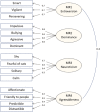Pet cat personality linked to owner-reported predation frequency
- PMID: 36713484
- PMCID: PMC9873523
- DOI: 10.1002/ece3.9651
Pet cat personality linked to owner-reported predation frequency
Abstract
The domestic cat, Felis catus, is one of the most popular and widespread domestic animals. Because domestic cats can reach high population densities and retain at least some tendency to hunt, their overall impact on wildlife can be severe. Domestic cats have highly variable predation rates depending on the availability of prey in their environment, their owners' practices, and individual cat characteristics. Among these characteristics, cat personality has recently been hypothesized to be an important factor contributing to variations in the hunting activity of cats. In this study, we surveyed 2508 cat owners living in France about their cats' personalities, using the Feline Five personality framework, and the frequency with which cats bring home prey. Personality traits were analyzed using factor analysis and related to predation frequency using cumulative logit models. For both birds and small mammals, cats with high levels of extraversion or low levels of neuroticism had significantly higher frequencies of prey return. Owners whose cats had low levels of agreeableness or high levels of dominance reported a significantly lower frequency of bird return. Personality differences therefore seem to contribute to the high variability in predation rates among domestic cats. We also found that the owner-reported prey return frequencies were significantly higher for cats spending more time outdoors, for non-pedigree cats, and for owners living in rural or suburban areas as opposed to urban areas. By contrast, we did not detect an effect of cat sex or age on their reported prey return rates.
Keywords: depredation; domestic cats; personality traits; urbanization.
© 2023 The Authors. Ecology and Evolution published by John Wiley & Sons Ltd.
Figures



References
-
- Baker, P. J. , Bentley, A. J. , Ansell, R. J. , & Harris, S. (2005). Impact of predation by domestic cats Felis catus in an urban area. Mammal Review, 35, 302–312.
-
- Baker, P. J. , Molony, S. E. , Stone, E. , Cuthill, I. C. , & Harris, S. (2008). Cats about town: Is predation by free‐ranging pet cats Felis catus likely to affect urban bird populations? Ibis, 150, 86–99.
-
- Barratt, D. G. (1997). Predation by house cats, Felis catus (L.), in Canberra, Australia. I. Prey composition and preference. Wildlife Research, 24(3), 263–277.
-
- Bennett, P. C. , Rutter, N. J. , Woodhead, J. K. , & Howell, T. J. (2017). Assessment of domestic cat personality, as perceived by 416 owners, suggests six dimensions. Behavioural Processes, 141, 273–283. - PubMed
-
- Blancher, P. (2013). Estimated number of birds killed by house cats (Felis catus) in Canada. Avian Conservation Ecology, 8, 3.
LinkOut - more resources
Full Text Sources
Miscellaneous

